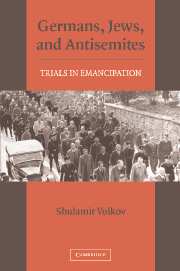Book contents
- Frontmatter
- Contents
- Preface
- Prologue: My Father Leaves His German Homeland
- PART I INTERPRETING THE DANGER SIGNS
- 1 Views from East and West
- 2 Excursus on Self-Hatred and Self-Criticism
- 3 Past Shadows, Present Needs
- PART II ANTISEMITISM AS A CULTURAL CODE
- PART III THE GERMAN-JEWISH PROJECT OF MODERNITY
- Epilogue: Closing the Circle
- Index
3 - Past Shadows, Present Needs
Published online by Cambridge University Press: 05 June 2012
- Frontmatter
- Contents
- Preface
- Prologue: My Father Leaves His German Homeland
- PART I INTERPRETING THE DANGER SIGNS
- 1 Views from East and West
- 2 Excursus on Self-Hatred and Self-Criticism
- 3 Past Shadows, Present Needs
- PART II ANTISEMITISM AS A CULTURAL CODE
- PART III THE GERMAN-JEWISH PROJECT OF MODERNITY
- Epilogue: Closing the Circle
- Index
Summary
The Kristallnacht and Other Pogroms
Despite past experience, when the Nazis came to power, the blindness of Jews and non-Jews alike seemed almost complete. It was this total distortion in perceiving reality that manifested itself most dramatically, indeed most tragically, at that final moment, when all hope for a respectable Jewish existence in Germany was lost, at the time of the Kristallnacht. By then, one could assume, the threat of further violence against the Jews could no longer be ignored. In those days, so it seemed, no particular insight and no long-term historical perspective were needed to understand that 1938 had been a fateful year. In fact, this was generally acknowledged well before the year was over. Historians, too, readily accept this diagnosis. By the end of 1938, the Nazis' intentions were easily apparent. Their determination to find a “solution” to the Jewish question could no longer be doubted. Their blatant disregard of world opinion was clearer than ever, and if it had still been possible to read “mixed signs” during earlier years, as historian Peter Gay passionately argued in his autobiography, the Kristallnacht finally brought home to the Jews the hopelessness of their situation. Approximately 150,000 Jews had left Germany between the Nazis' ascent to power on January 30, 1933, and November 1938, with almost one-quarter of them leaving during 1933 alone. In the aftermath of the Kristallnacht, emigration took on new proportions. Nearly 120,000 Jews left Germany in 1938–39 alone.
- Type
- Chapter
- Information
- Germans, Jews, and AntisemitesTrials in Emancipation, pp. 47 - 64Publisher: Cambridge University PressPrint publication year: 2006



